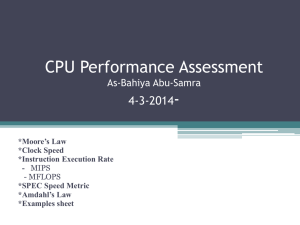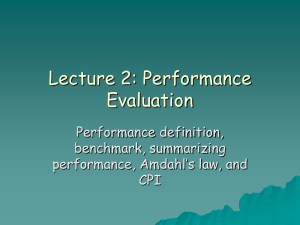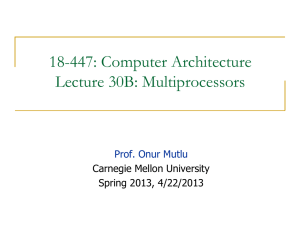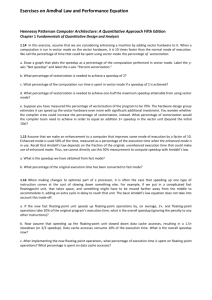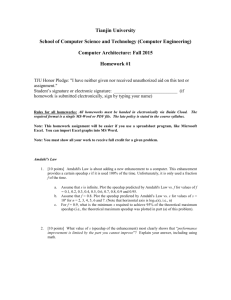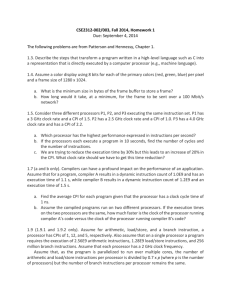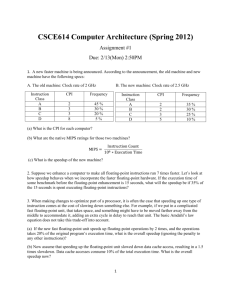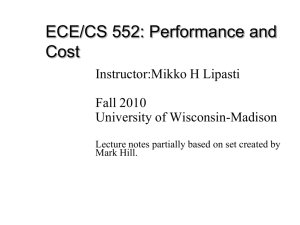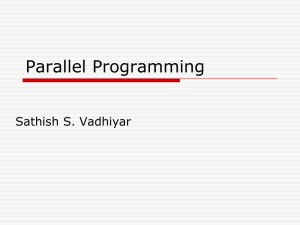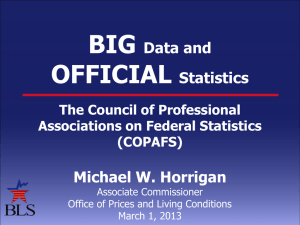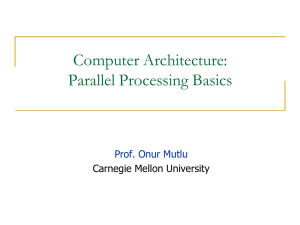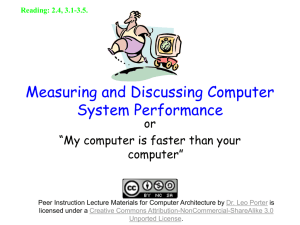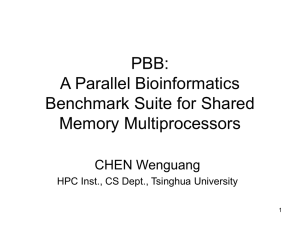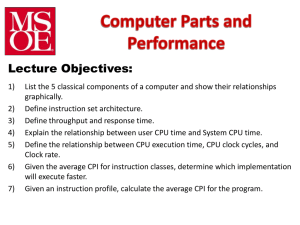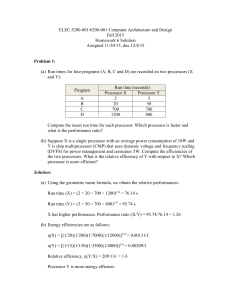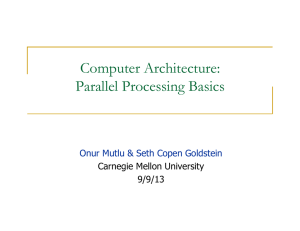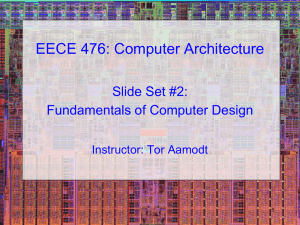Lecture #1
advertisement
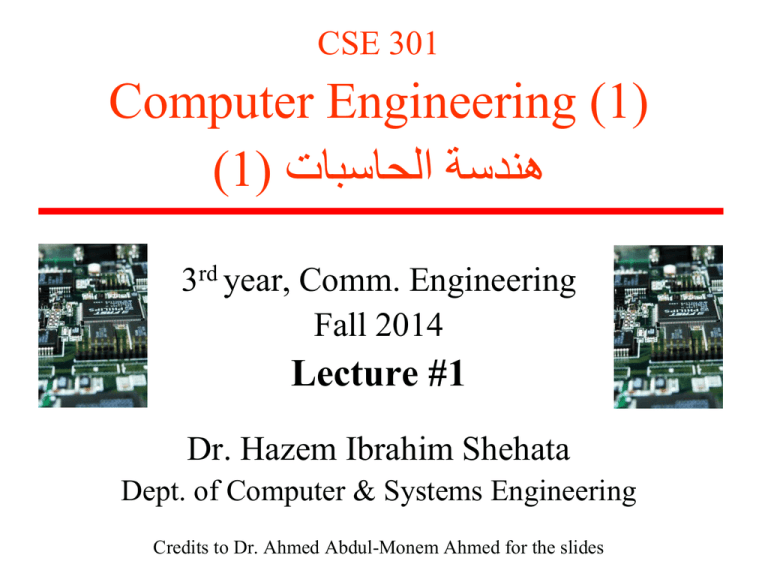
CSE 301 Computer Engineering (1) )1( هندسة الحاسبات 3rd year, Comm. Engineering Fall 2014 Lecture #1 Dr. Hazem Ibrahim Shehata Dept. of Computer & Systems Engineering Credits to Dr. Ahmed Abdul-Monem Ahmed for the slides Teaching Staff • Instructor: —Hazem Ibrahim Shehata —Email: hshehata@uwaterloo.ca —Lectures: Thursday 10:15am-1:00pm —Office Hours: TBA • Teaching Assistant: —Hisham Abdullah —Email: eng_hisham22@yahoo.com —Tutorials: TBA —Office Hours: TBA Course Info • Course website: —www.hshehata.staff.zu.edu.eg/courses/cse301 • Textbook: —“Computer Organization and Architecture: Designing for Performance”, William Stallings, 9th Edition, 2013, www.williamstallings.com/ComputerOrganization Course Info (Cont.) • Grading: Course work Grade distribution Participation 5pt Assignments 15pt Midterm Exam 30pt 50 Final Exam 100pt Total Points 150 Course Overview • Ch. 1: Introduction • Ch. 2: Computer Evolution and Performance • Ch. 3: A Top-Level View of Computer Function and Interconnection • Ch. 4: Cache Memory • Ch. 12: Instruction Sets: Characteristics and Functions • Ch. 13: Instruction Sets: Addressing Modes and Formats • Ch. 14: Processor Structure and Function Ch. 1: Introduction Organization vs. Architecture (1) • Architecture: attributes visible to the programmer. — Instruction set, number of bits used for data representation, I/O mechanisms, addressing techniques. — Ex.: Is there a multiply instruction? • Organization: how features are implemented. Such details may be hidden from programmer. — Control signals, interfaces, memory technology, number of cores. — Ex.: Is there a hardware multiply unit or is it done by repeated addition? Organization vs. Architecture (2) • All Intel x86 family share the same basic architecture. • This gives code compatibility, at least backwards. • Organization differs between different versions (e.g., Core i3/i5/i7, Xeon, Atom, … etc.) Hardware Structure vs. Function • Structure: the way in which components relate to each other. • Function: the operation of individual components as part of the structure Structure - Top level Computer Peripherals Central Processing Unit Computer Main Memory Systems Interconnection Input Output Communication lines Structure - CPU CPU Arithmetic and Login Unit Computer Registers CPU Memory System Bus I/O Internal CPU Interconnection Control Unit Structure – Control Unit Control Unit CPU Registers Internal Bus Control Unit ALU Sequencing Logic Control Unit Registers and Decoders Control Memory Function • All computers have the following functions: —Data storage —Date processing —Data movement —Control Functional View of a Computer Data Storage Facility Data Movement Apparatus Control Mechanism Data Processing Facility Data Movement • e.g., keyboard to screen. Data Storage Facility Data Movement Apparatus Control Mechanism Data Processing Facility Storage • e.g., Internet download to a disk. Data Storage Facility Data Movement Apparatus Control Mechanism Data Processing Facility Data Processing to/from Storage • e.g., updating a bank statement. Data Storage Facility Data Movement Apparatus Control Mechanism Data Processing Facility Data Processing from Storage to I/O • e.g., printing a bank statement. Data Storage Facility Data Movement Apparatus Control Mechanism Data Processing Facility Chapter 2: Computer Evolution and Performance Performance Assessment • Factors considered in evaluating processors: —Cost, size, power consumption, …, and performance. • Performance: amount of work done over time. Work Performanc e Time • Time measurement is straightforward! —seconds, minutes, hours, … etc. • Work measurement is system-specific! —# of tasks performed, # of products completed, # of things done … etc. • Ex.: Car assembly line: —Performance = number of cars assembled every hour. Processor Performance • Processor performance is reflected by: —Instructions-per-second (IPS) rate (Ri): number of instructions executed each second. When instructions are count in millions, this becomes MIPS rate (Rm). —Programs-per-second (PPS) rate (Rp): number of programs executed each second. • Processor performance parameters: 1. Clock speed (f) (in cycles/second or Hz) – – – Processor goes through multiple steps to execute each instruction. Each step takes one clock cycle to be performed. Duration of each clock cycle (cycle time τ) = 1/f Processor Performance Parameters • Processor performance parameters (Continued): 2. Instruction count (Ic) (in instructions) – Number of machine instructions executed for a given program to run from start until completion. 3. Cycles per instruction (CPI) (in cycles/instruction) – – – Number of clock cycles taken to execute an instruction. Different types of instructions have different CPI values! Average CPI for a program with n different types of instructions: n CPI x 1 CPI x I x Ic Ic: instruction count for the program. Ix: number of instructions of type x. CPIx: CPI for instructions of type x. Performance Metrics CPI • Av. time to execute instruction: Ti CPI f 1 f • IPS rate: Ri Ti CPI Ri f • MIPS rate: Rm 6 10 CPI 10 6 I c CPI • Av. time to execute program: Tp I c Ti f 1 f • PPS rate: R p Tp I c CPI Performance Calculation Example • A 2-million instruction program is executed by 400-MHz processor. • Program has 4 types of instructions: Instruction Type CPI Instruction Mix (%) Arithmetic and logic 1 60 Load/store (Cache hit) 2 18 Branch 4 12 Load/store (Cache miss) 8 10 • CPI = (1 * 0.60) + (2 * 0.18) + (4 * 0.12) + (8 * 0.10) = 2.24 • Rm = (400 * 106) / (2.24 * 106) ≈ 178 • Rp = (400 * 106) / (2.24 * 2 * 106) ≈ 89 Benchmarking • Ri and Rm can’t be used to compare performance of processors with different instruction sets! —Ex.: CISC vs. RISC • Alternative: Compare how fast processors execute a standard set of benchmark programs. • Characteristics of a benchmark program: —Written in high-level language (i.e., machine independent). —Representative of a particular programming style and application. —Measured easily. —Widely distributed. SPEC benchmarks • Best known collection of benchmark suites is introduced by the System Performance Evaluation Corporation (SPEC). • Examples of SPEC benchmark suites: —SPEC CPU 2006: 3-million lines of code of processorintensive applications – SPECint2006: 12 integer programs (C and C++) – SPECfp2006: 19 floating-point programs (C, C++ & Fortran). —SPECjvm2008: java virtual machine —SPECweb2005: web server - no longer maintained! —SPECmail2009: mail server – no longer maintained! —… SPEC Speed Metric (rg) • SPEC defines a base runtime (Trefx) for each benchmark program x using a reference machine. • Runtime of system-under-test (Tsutx) is measured. • Result of running benchmark program x on system-under-test is reported as a ratio (rx): Tref x r x Tsutx • Overall result of running n-program benchmark suite is the geometric mean (rg) of all ratios: 1/ n r g rx x 1 n Ex.: SPECint2006 on Sun Blade 6250 • Sun Blade 6250: 8 processors (2 chips * 4 cores) • Benchmark program 464.h264ref (Video encoding): —Trefx = 22135s, Tsutx = 934s rx = 22135/924 = 23.7 • Ratios of all SPECint2006 benchmark programs: • Speed metric (rg): —rg = (17.5 * 14 * 13.7 * … * 14.7)1/12 = 18.5 Amdahl’s Law • Proposed by Gene Amdahl in 1967. • Deals with potential speedup of a program execution by multiple processors. • Speedup: ratio between program execution time on single processor to that on N processors. • Amdahl’s law: if a program takes time T to be executed by a single processor, and only a fraction f of that program can be executed in parallel using N processors, Then: T * (1 f ) T * f 1 Speedup T* f f T * (1 f ) (1 f ) N N Conclusions of Amdahl’s Law • Amdahl’s law has two important conclusions: 1. Parallel processors has little effect when f is small! – When f goes to 0, speedup goes to 1. 2. Speedup is bound by 1/(1–f) regardless of N! – When N goes to ∞, speedup goes to 1/(1–f). • Amdahl’s law can be generalized to deal with any system enhancements. • Generalized Amdahl’s law: if an enhancement speeds up execution of a program fraction f by a factor k, then: Execution tim e before enhancem en t 1 Speedup f Execution tim e after enhancem en t (1 f ) k Amdahl’s Law for Multiprocessors Reading Material • Stallings, Chapter 1: —Pages 7 – 13 • Stallings, Chapter 2: —Pages 49 – 57
